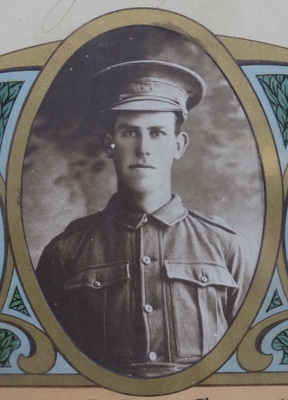A century on from the end of World War I we acknowledge their service …
Lest we forget.
Lance Corporal Albert Francis Nye
Born: 1 December 1889 near Benalla. Died: 21 May 1961 Heidelberg.
Enlisted: 24 March 1916 aged 26.
Served: Western Front.
Albert was the son of James Nye and Mary Ann Thomas, who later settled on 139 acres at “Gembrook South” (now Pakenham Upper). His brother Edward owned a property in “Close’s subdivision” off Army Road. Albert also became a farmer, presumably working on the family’s properties, and played football for “Gembrook South” with a number of other men who would later enlist for WWI, including Ted Appleton, John Doyle and Charles Warner.
When he enlisted on 24 March 1916, Albert was 26. The Pakenham Upper community farewelled Albert, together with John Doyle and Robert Black at a special function held at the Pakenham Upper Mechanics’ Institute on Easter Monday, 1916. During the social event, the three soldiers were wished “God speed and a safe return” by Frank Wisewould, a prominent local identity and presented with wrist watches as mementos. Albert left Melbourne on the HMAT Nestor, bound for England and what Albert described as his “new life”. His mother and sister saw him off, giving him some cake and lemons before he went aboard the ship.
In April 1917, Albert proceeded overseas to France, where he was taken on strength with the 24th Battalion in early May, and appointed as Lance Corporal just before the Second Battle of Bullecourt. After that battle, Albert was appointed as an acting Corporal, but reverted to the rank of private on being evacuated to hospital sick with influenza.
Albert rejoined his battalion on 1 October 1917 only to be wounded in action a few days later during the Third Battle of Ypres, being gassed on on 22 March 1918. The gassing left Albert with a terrible cough for the rest of his life. While in England recovering, Albert received training with a machine gun company. In late September/early October 1918, the 2nd Machine Gun Battalion participated in the Allied attack on the Hindenburg Line at the St Quentin Canal and Beaurevoir. Albert was wounded for a third time, in the leg, on 3 October. He was again invalided back to England and hospitalised in Birmingham, listed in the same casualty list as Albert was his former football team mate Ted Appleton.
By the time this list was published back home, the Armistice had already been declared.
Albert returned to Australia in early 1919 and was given a “hearty welcome” by his family and friends at Pakenham Upper. In October 1919, he and other returned soldiers were presented with special certificates by the grateful Pakenham Upper community.
In 1920, Albert married Alice Maude Beadle and they later raised a family. By 1924, Albert and Alice had moved to Bentleigh, where they lived for many years. Albert worked as a carpenter.
During WWIII Albert enlisted again, this time serving as a Lance Sergeant in the Volunteer Defence Corps. Albert’s eldest son also served in WWII and spent three and a half years as a POW of the Japanese on the island of Ambon in the Dutch East Indies. Remembered by his family as a wonderful husband, father and grandfather.
In 2015, Albert’s story, as told by his grand-daughter Carol Kelly, was included as one of 150 stories included on the Victorian Government’s Anzac Centenary website. Albert’s photograph also featured on a Melbourne Tram honouring Victoria’s Anzacs.
This is an extract from Patrick Ferry’s book A Century After The Guns Fell Silent – Remembering the Pakenham District’s WWI Diggers 1914-18.
For more details on this and other profiles in the book, head to the website www.pakenhamww1.com







